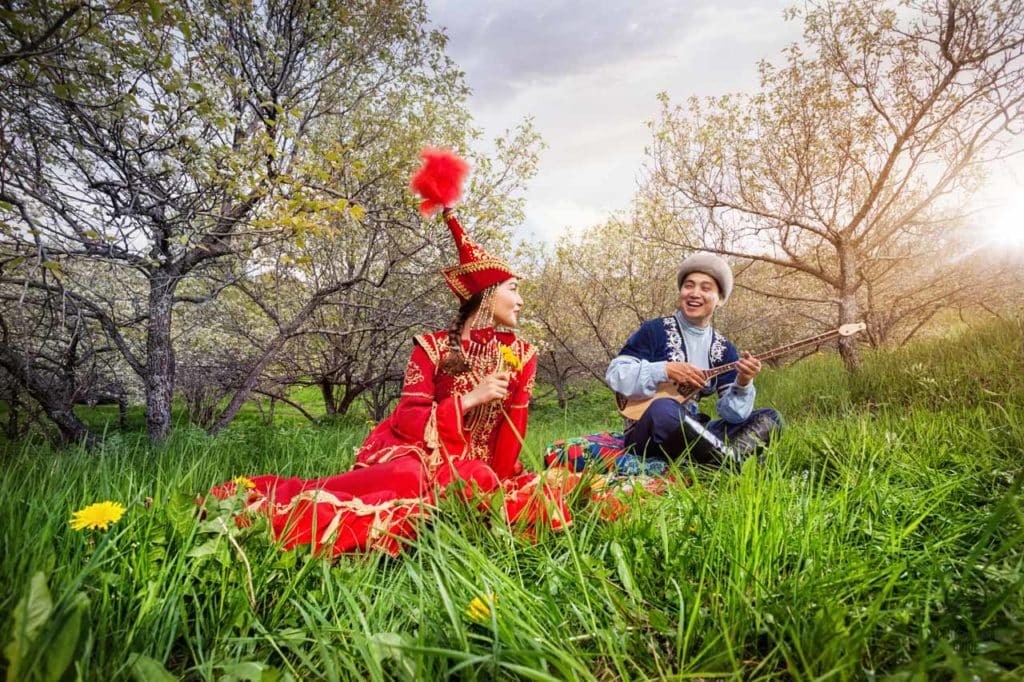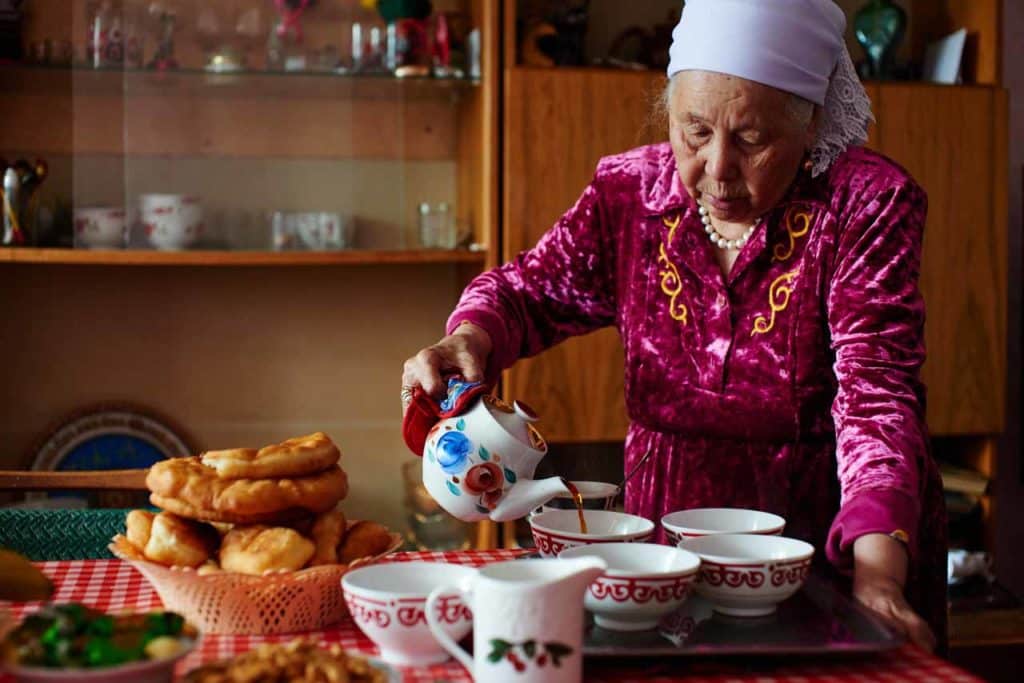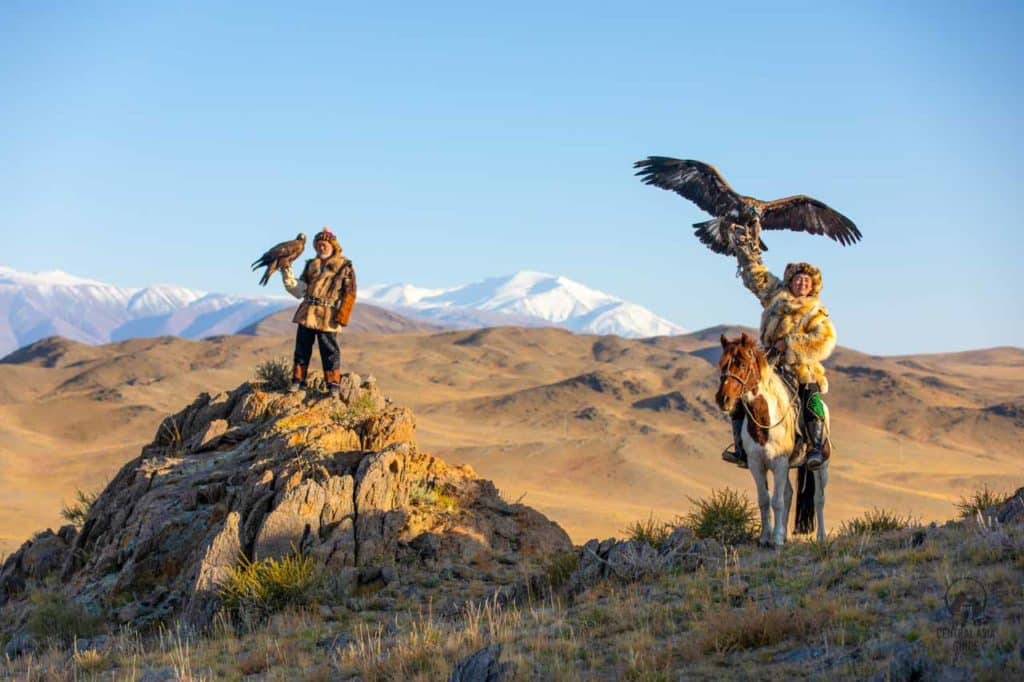Kazakh culture and traditions
Kazakh Culture, customs, clothing, cuisine, games and more
Kazakhstan is a multinational and multicultural country with a vast territory. Kazakh culture is not only a mixture of nations, but it has also inherited a lot from different nearby cultures, including China, Mongolia, and other Turkic cultures (like Kyrgyzstan) and, of course, Russia. Despite such a blend of cultures, each nation of Kazakhstan has carefully preserved its cultural traditions and customs.
The core of Kazakh culture comes from their pastoral nomadic way of life which is best preserved in the Almaty and East Kazakhstan’s Altai regions, where Tengrism is still also practiced. The western part of the country has a different culture due to the Caspian Sea and the more semi-desert landscape.
Kazakh culture includes the traditional yurt dwelling, a tent made of felt, which is still often used as a home and as a modern decorative object. In practice, yurts are used mostly by the nomads in the rural areas. Another very traditional form of Kazakh culture is the clothing that has adapted to the harsh steppe climate, and the nomad lifestyle of Kazakhs including games, crafts and several celebration rituals. The best way to observe the Kazakh culture is through our Kazakhstan Tours or Central Asia Tours. Kazakh culture, like the other Central Asian cultures, also draws from the Zoroastrianism, better known as fire worshipping.


Kazakh yurt
The circular, felt-covered yurt is a potent image of Kazakh culture. Few Kazakhs now live in yurts, although they are still used by some animal herders who move their animals into summer mountain pastures.
Camels in Kazakhstan
Camels played earlier an essential role in the life of nomads in different ways: as working animals (pack, harness, riding), and as a source of milk, meat, wool, and leather.
Kazakh Steppe
Kazakhstan contains a wide variety of habitats, but of these, it is the steppe, the vast belt of dry grassland running across the country, which is at the heart of the Kazakh identity. Steppes are mostly too dry for the cultivation of crops and have therefore promoted nomadic husbandry as the way of life to Kazakh culture.
The steppe landscapes, with their scent of wormwood and billowing waves of feather grass, are an enduring memory of a journey across Kazakhstan, even if the passage may at the time seem monotonous. As a summary, the steppe is the essence of Kazakhstan, its nature, its people, and its culture.
There is nothing more evocative of Kazakhstan than to sit in the steppe on a mid-May afternoon, far from roads and listening to the lark singing while soaring in the winds, watching the waving wild tulips and experiencing the billowing cumulus clouds as they scud across the empty skies.
The steppe is the sound of the wind, the sun, the herbal scent of the saxaul (Artemesia) plant and the view of distant Kazakh grave sites atop a small rising hill breaking the flatness. The Kazakhs, more than any other Central Asian nation, are a people of the steppes and most of their culture has emerged from it.


Kazakh nomad culture
The nomadic way of life never really died out in Kazakhstan. The Kazakhs and their ancestors have preserved nomadic traditions on the open steppe and the surrounding mountain and hill areas for 3 000 years.
Kazakh Cuisine
Kazakh cuisine is profoundly based on the nomadic past of the Kazakh people. The meat has always been dominated in the main meal with primarily mutton and horse together with numerous milk products.
The methods of preparation were developed essentially for securing food preservation. Kazakh cuisine is an inseparable part of the Kazakh nomad culture that mostly comprises of heavy meat based dishes. Kazakh and Kyrgyz foods are mostly very close to each other with minor differences.
Kazakh national clothing
Kazakh traditional clothes have a long history that reflects the Kazakhs lifestyle in the steppes. The region has very hot summers strong winds and the bitter cold of winter. Therefore clothing was mainly made of woolen, cottony silk, or velvet fabrics, and outer garments were usually lined with fur.
Kazakh national crafts
Kazakhstan has its unique folk crafts that originated in antiquity and developed over the years. Kazakh folk crafts formed under the influence of the nomadic culture of the Kazakh tribes. The tough and harsh life of the nomads forced Kazakh nomads to independently make everything they needed for life from what they had at hand.
Kazakh customs & traditions
Aytys
Aitys (or Aitysh) is a singing contest, held between two agyns (improvising poets and singers in Kazakh and Kyrgyz cultures). In Aitysh performance, agyns usually play a national instrument called dombra and respond to each other in spontaneous rhyming verses on various topics.
Sometimes they can make sarcastic political statements, criticize each other’s style, flirt (in case of the opposite sex) and even insult one another. However, they emphasize that it is all done in good humor. In 2015 the joint Kazakh-Kyrgyz nomination “Aitys/Aitysh, as the art of improvisation” was included on the List of the Intangible Cultural Heritage (ICH) of Humanity.
"Shashu" - to throw Throw candies and coins during celebrations
Shashu is the act of showering people with sweets and money during a particular celebration, believed to bring good luck. Usually the people who are the “target” of the sweets, are expected to collect them. Shashu is customary not only in Kazakhstan, but also in Kyrgyzstan.
Kazakh National Games
Physical contests are massively popular in Kazakhstan; from wrestling in a ring to wrestling on horseback, from archery to various forms of horsemanship, all are popular at the celebrations.
Kazakhstan National Holidays
Kazakhstan celebrates a huge number of festivals. One of the most popular one is Nauryz. It is a New Year’s eve according to the ancient Oriental calendar and the day of the spring equinox.
Famous Kazakh people
There are several notable people from Kazakhstan whose main contribution to Kazakh culture and folklore has been through poetry, songs, writings and philosophy.
Kazakh National Instruments
Music played a hugely important role for the nomadic Kazakhs. The most famous traditional instruments are string instruments such as the dombra the oldest Kazakh music instrument.
Kazakh products
Kazakhstan domestically produced goods are highly valuable for guests. Here you can find high-quality felt products, beautiful ornamented Kazakh jewelry and unique leather products.
Kazakh Festivals
Kazakhstan, the heart of Central Asia, is a land of diverse cultures and ancient traditions that come alive through its vibrant festivals.
Where to experience Kazakh culture?
See also Kyrgyz, Uzbek, Turkmen and Tajik cultures
Page updated 1.1.2023